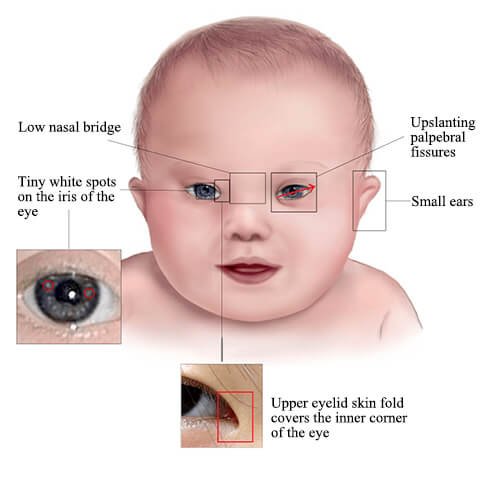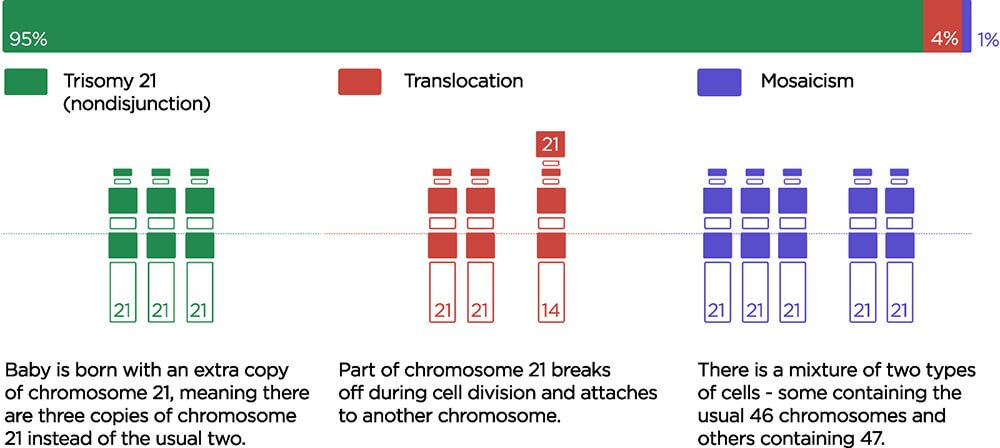Down syndrome is a genetic condition in which a child is born with an extra copy of chromosome 21. It is caused by an extra copy of chromosome 21 in a baby’s cells. It happens by chance at birth, and there is still no proof that it is the result of any behaviors taken before or during pregnancy. A baby with Down syndrome will be born in about one out of every 700 pregnancies, with the risk increasing as the pregnant woman’s age rises. Down syndrome screening as part of prenatal care could help detect the disorder before the baby is born.
Appearance
Individuals with Down syndrome tend to have certain physical features in common. These may include:
- Low nasal bridge
- Flattened facial profile
- Short neck, with excess skin at the back of the neck
- Small head, ears, and mouth
- Upward slanting eyes, often with a skin fold that comes out from the upper eyelid and covers the inner corner of the eye
- White spots on the colored part of the eye (called Brushfield spots)
- Wide, short hands with short fingers
- A single, deep, crease across the palm of the hand
- A deep groove between the first and second toes
Health
People with Down syndrome may have the following health problems:
- Slower Growth: This is often associated with some impairment of their cognitive ability and physical growth. Individuals with Down Syndrome tend to have a lower-than-average cognitive ability, and need more time to adapt and learn.
- Congenital Heart Disease: Individuals with Down syndrome have a higher risk of congenital heart defects; 40-60% of babies born with Down Syndrome may need heart surgery during childhood. Heart problems may also lead to other complications, such as pneumonia.
- Ears: Recurrent ear infections, with cases of hearing loss or deafness.
- Eyes: Conditions such as myopia, strabismus (crossed eyes), and blocked tear ducts leading to frequent watery eyes.
- Thyroid dysfunctions which may lead to emotional and physical problems.
- Poor muscle tone results in weaker motor skills such as inflexible fingers, making tasks like buttoning a shirt more difficult. Obstructive sleep apnea.
- A tendency towards obesity.
Causes of Down Syndrome Types
People with Down syndrome are born with an extra chromosome. There are three possible causes:
Trisomy 21
The first possibility is Trisomy 21, which affects approximately 95% of the patients. Trisomy 21 patients have three number 21 chromosomes rather than two. Humans, on the other hand, typically have 23 pairs of chromosomes, each with its own piece of DNA.
Translocation
Translocation is the second possible cause, which occurs in about 4% of cases of Down syndrome. It is caused when the total number of chromosomes in the cells remains 46. As a result of an additional full or partial copy of chromosome 21 joins another chromosome, chromosome 14, which would cause the characteristics of Down syndrome.
Mosaicism
Mosaicism, the third cause, occurs when a patient with Down syndrome has an additional 21st chromosome in some of their cells. Whereas the other cells have a pair of 21st chromosomes, as expected. This type affects about 1% to 2% of patients with Down syndrome.
Down syndrome diagnostic tests during pregnancy
There are two basic types of Down syndrome tests: screening and diagnostic tests.
Screening Tests
- First-trimester screening : Between the 11th and 14th week of pregnancy, you will be subjected to an ultrasound examination for umbilical cord permeability (nuchal translucency scan or NT scan). An unusually high umbilical cord translucency is associated with chromosomal and congenital birth abnormalities. On the same day, a blood test for Pregnancy Associated Plasma Protein A (PAPP-A) and human chorionic gonadotropin (hCG) levels will be conducted. Up to 90% of Down syndrome pregnancies are detected with the first-trimester screening test.
- Second trimester screening : Between the 15th and 20th week of pregnancy, Another blood test will conducted for alpha-fetoprotein (AFP), human chorionic gonadotropin (hCG) and Estriol (E3) and inhibin-A. This 2nd trimester screening test detects around 80% of Down syndrome pregnancies. Approximately 5% of women will receive a positive screening result, indicating a high risk of getting a baby with Down syndrome. In case the test results are positive, you will be notified and encouraged to take a diagnostic test.
Diagnostic Tests
Diagnostic tests include chorionic villus sampling (CVS) and amniocentesis. A diagnostic test can determine whether or not the baby has Down syndrome or any other genetic condition. Under ultrasound guidance, a needle is inserted into the uterus to extract placental cells or amniotic fluid for chromosomal analysis. Amniocentesis is typically completed between the 15th and 20th week, and a chorionic villus sample is usually conducted between the 10th and 13th week. Diagnostic tests are usually very safe procedures, but there is still a significant increase in the risk of miscarriage after either treatment.
What if the genetic disease is discovered in the pregnancy?
The doctor will examine the concept of the genetic disorder, its impact on the baby, and the subsequent risk pregnancies to the couple. The pregnant can talk to her doctor about what kind of help is available from hospitals and other institutions, and she will be better prepared for her baby’s birth. Babies with Down syndrome can live semi-independently with the guidance of specialized care and education, as well as community assistance.
What is the Down Syndrome Life Expectancy?
|



